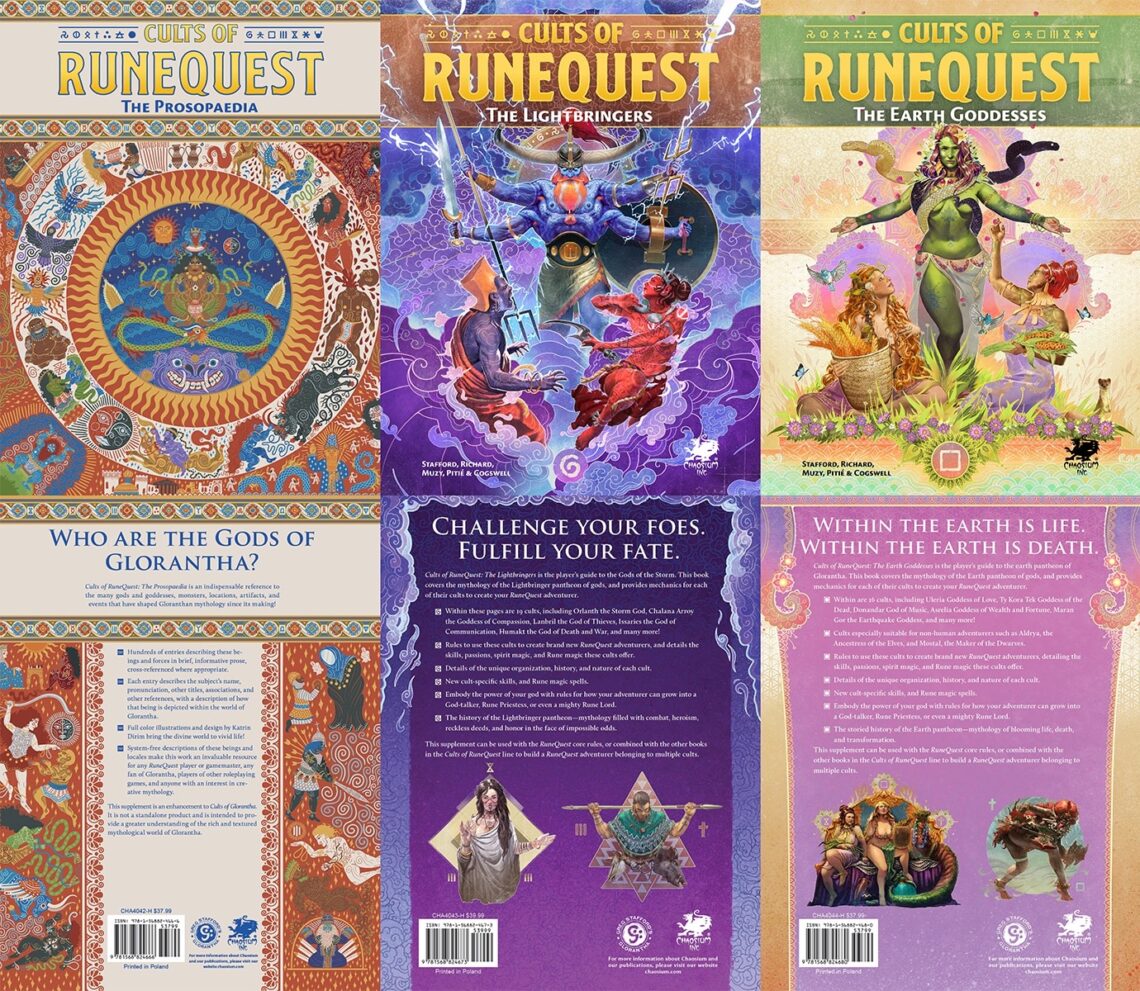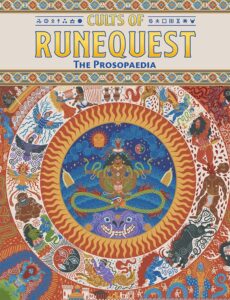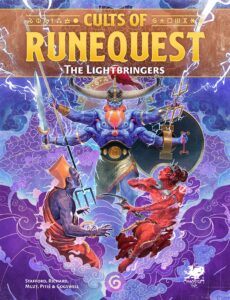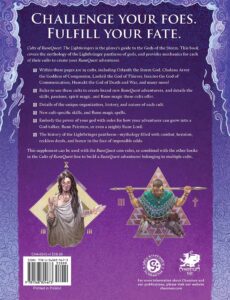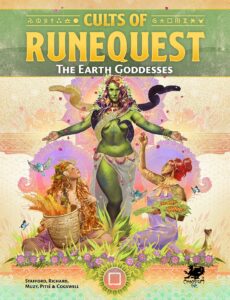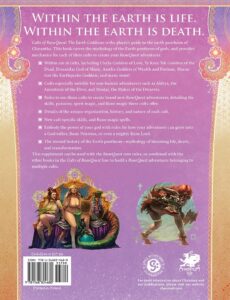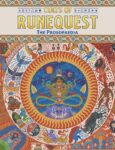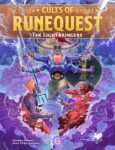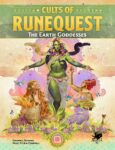What is the Cults of RuneQuest series
A Sneak Peek into the Making
Let me take you on a little journey of excitement, anticipation, and sheer delight. If you’ve been hanging around the gaming circuit, and more specifically, a fan of RuneQuest, you’ve probably heard whispers about the ‘Cults of RuneQuest.’ Well, those whispers became loud conversations for me quite early on!
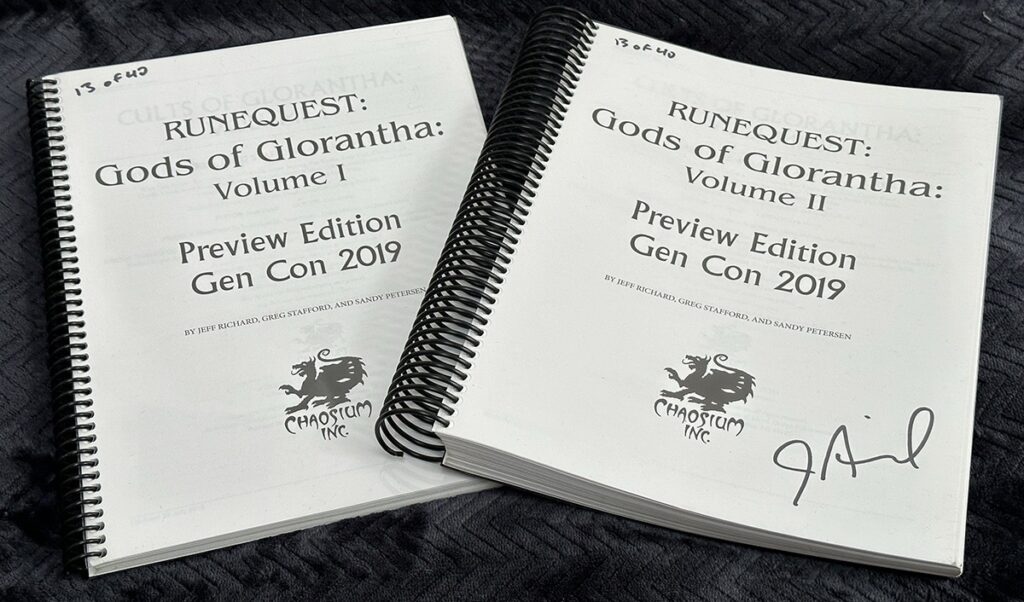
Flashback to Gen Con 2019, where the air was thick with the thrill of gaming novelty. Chaosium gave attendees a little sneak peek at what was then titled ‘Gods of Glorantha.’ Even then, the promise of a two-volume series had fans buzzing. Naturally, my gaming instincts kicked in, and I snagged a copy. My gaming group and I wasted no time diving into the goldmine of details, which we incorporated into our sessions.
Over the years, I’ve had the chance to chat with Jeff Richard about the evolving scope of this project. And every chat revealed something more intriguing. From the initial art teases on his Facebook to the casual (and might I say shocking) mention that this project grew from two volumes to a whopping ten! Each reveal was like leveling up in excitement.
A Confluence of Conventions
Then came Chaosium Con 2023. Picture this: a bustling venue, passionate gamers everywhere, and amid this, a shelf or two of “The Prosopaedia” debuted. I was lucky when I strolled up to the Chaosium booth just as a dozen or so copies were left, and voila, I had my hands on not one but two copies! Meanwhile, Jeff seemed to have become one with the proofs of the first four (or was it five) books, always with the stack in hand. And though I only got to admire the covers of the rest, the panel discussion about them was nothing short of fascinating.
Enter Gen Con 2023. I could not attend this year, but even online, the buzz was palpable as these books hadn’t hit the broader market yet, but guess what? Chaosium had copies of “The Lightbringers” and “The Earth Goddesses” up for grabs! And here’s a shoutout to my good friend and fellow enthusiast, Andrew Bean, for securing copies on my behalf.
The Unveiling
In just over a month since the release of the inaugural book “The Prosopaedia,” Chaosium’s “Cults of RuneQuest” series has swiftly expanded to include two more intriguing titles, “The Lightbringers” and “The Earth Goddesses.” “Cult of RuneQuest” is slated to expand to ten-volume series intricately crafted for their renowned game, RuneQuest, exploring the mythology, cults, and gods of Glorantha. Glorantha’s rich tapestry is central to the allure of RuneQuest, and while the core book equips gamers with the essentials, the “Cults of RuneQuest,” series elevates the experience by unveiling a myriad of options and a more profound exploration of the mythological landscape. With the fourth installment, “Mythology,” set for an October release alongside the new “Basic Roleplaying” book, and the fifth, “The Lunar Way,” anticipated in early 2024, the series hints at further explorations into pantheons such as The Sky Gods, The Sea Gods, The Darkness Gods, Chaos, and possibly the Invisible God or Spirits. For avid RuneQuest enthusiasts, this series promises an unparalleled discovery of the game’s expansive universe.
The ‘Cults of RuneQuest’ Series: A Deep Exploration of Glorantha Myth

Glorantha is not just a backdrop for the RuneQuest roleplaying game; it’s a vast, living world resonating with myths and legends. The ‘Cults of RuneQuest’ series provides a lens through which players and enthusiasts can better understand the intricate spiritual underpinnings of this realm.
With ten planned books, several ready for printing and, from what I’ve heard, the rest nearly there, each volume focuses on a distinct pantheon or religion that has shaped Glorantha’s cultural and mythic landscape. Each provides a thorough examination, offering readers both breadth and depth of understanding.
As part of the ten volumes series, there’s also the aforementioned “Prosopaedia,” a comprehensive guide that is an invaluable companion. It catalogs the deities, traces critical events, and maps out significant locales in the Gloranthan myth. Equally important is the forthcoming “Mythology” book, which threads together the overarching narrative of the realm, capturing the essence of the Gloranthan monomyth. That’s due out in October (along with the print version of the new ORC Licensed Basic Roleplaying).
In a sense, the ‘Cults of RuneQuest’ series reminds me of nothing so much as the classic Time-Life book series such as The Old West or The Enchanted World that covered a particular topic broadly and completely. The ‘Cults of RuneQuest’ is more than just an addition to a gamer’s library—it explores a world’s spiritual and mythical dimensions. While the series is undeniably informative, its true strength lies in its ability to immerse readers, making them feel a part of Glorantha’s vast tapestry.
Consistency and Quality from Chaosium
One of the standout elements of the ‘Cults of RuneQuest’ series is undoubtedly its production quality. With its long-standing reputation for delivering top-tier roleplaying game resources, Chaosium doesn’t disappoint with this latest addition to its collection.
The layout of each book has been thoughtfully designed, ensuring readers can easily navigate its contents. Font choices are clear and legible, making prolonged reading sessions comfortable and engaging. This attention to detail is a testament to Chaosium’s dedication to providing a superior reading experience.
Visually, the books are a treat. Simeon Cogswell’s layout is superb. The color schemes used for headings and sidebars aren’t merely aesthetic choices—they cleverly resonate with the respective pantheon each book focuses on. This touch not only adds a thematic richness to each volume but also aids in creating a cohesive reading atmosphere. Chaosium took to heart the importance of ensuring each book, while part of a series, offers a distinct experience.
Another notable feature is the comprehensive indexing. Anyone who has ever been frustrated by the inability to locate specific content in a resource book quickly will appreciate the effort Chaosium has put into this. Materials and references are just a quick thumbing away, making these books as practical as they are beautiful.
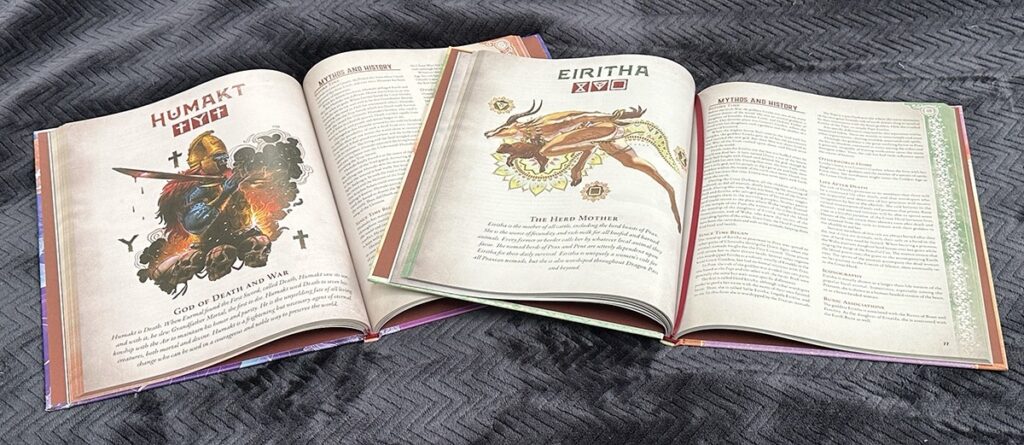
Art par excellence in ‘Cults of RuneQuest’
When discussing the ‘Cults of RuneQuest,’ it’s impossible not to shed light on the artistic brilliance that embellishes its pages. The art, I must emphasize, is not just complementary to the text; it’s transformative and elevates the reader’s experience to a realm that words alone might not reach.
One of the most riveting aspects of the art is its dual nature. It masterfully flits between the fantastical elements of Glorantha and the more familiar nuances of our own reality. This interplay makes the lore tangible, creating an uncanny bridge between the known and the mysterious.
Three artists, in particular, stand out with their unique contributions: Loïc Muzy, Agathe Pitié, and Katrin Dirim.
Loïc Muzy’s work is a revelation. His renderings of the gods are not merely illustrations but narratives in themselves. There’s an intimacy in how he portrays these divine entities, making them feel simultaneously awe-inspiring and accessible. His artistry doesn’t just depict; it tells a story, often catching the observer off-guard with its depth and layers of meaning.
Agathe Pitié’s style feels like a dreamy voyage into the depths of the Jungian psyche. Her work has an ethereal quality, almost like she’s tapping into collective unconsciousness and laying it out on paper. Her illustrations remind us of the archetypal symbols and motifs that resonate universally across cultures and eras. With Pitié, it feels less like you’re observing art and more like diving into a reflection of shared human experience.
While the spotlight shines brightly on Muzy and Pitié, Katrin Dirim’s contributions cannot be overlooked. Although I touch upon her briefly here, her pieces offer a fresh perspective and complement the overall artistic vision of the series. She also provides beautifully illustrated genealogical tables for each pantheon.
The ‘Cults of RuneQuest’ does not merely stand out for its profound lore and gaming mechanics for cult members. The art is focal, playing an equally significant role in making these books the treasures they are. The combined efforts of these talented artists ensure that readers are informed and truly moved. It’s a visual odyssey that should be noticed.
Chaosium continues its tradition of marrying form with function for high-quality production, beautiful artwork, thoughtful layout, and organization. The ‘Cults of RuneQuest’ series is a shining example of this ongoing commitment.
Is Cults of RuneQuest for You
In the expansive realm of roleplaying game resources, identifying the intended audience for a series is pivotal. Who is the target of the ‘Cults of RuneQuest’ series?
If imaginative mythologies captivate your senses, these volumes offer a treat. The series paints a vivid tableau of Gloranthan beliefs and tales, ensuring hours of engrossing reading. This stands true even for those who may not be acquainted with the intricacies of RuneQuest’s gameplay mechanics.
The core appeal of the series lies in its adaptability. Both the novice and veteran players and gamemasters of RuneQuest will deem these books essential. Within their pages, a reservoir of information awaits, catering to all aspects of Gloranthan adventures. Whether you’re on a mission to outline a character’s spiritual arc or craft intricate tales as a gamemaster, these books are your trusty companions.
However, you may want to be selective to optimize the gaming experience and protect your wallet. If your adventures are set in RuneQuest’s Dragon Pass, titles like ‘The Lightbringers’ and ‘The Earth Goddesses’ might be your primary picks. Consider adding ‘The Lunar Way’ upon its release. Yet, if an exhaustive grasp is what you seek, the allure of the entire collection is hard to resist.
The ‘RuneQuest: Roleplaying in Glorantha’ rulebook is a recommended companion. It lays down the foundational rules, offering gaming context to the series. And come October, the ‘Mythology’ book is set to release, offering a more profound exploration of Glorantha and further enriching the series’ landscape.
Additionally, titles like ‘The Red Book of Magic’ and other RuneQuest offerings might pique your interest. Though not mandatory, they promise to amplify the reader’s expedition. However, the primary titles stand firm despite their absence, ensuring a rewarding journey.
The ‘Cults of RuneQuest’ series is a versatile gem catering to a diverse audience — from the seasoned RuneQuest loyalist and the budding gamemaster to the casual reader intrigued by mythical narratives.
What’s Inside Each Book
The organization of the ‘Cults of RuneQuest’ book.
At the very outset of each book, readers are greeted with an overview of the respective pantheon covered in each book. Rather than merely presenting a dry introduction, the series tackles the profound questions that every individual, regardless of their time or place, has grappled with:
- Where does the world come from? The origins of the universe.
- Where do I come from? Why am I here? Personal existence and purpose.
- Why do we die? What happens after we die? The inevitable mystery of death
- How do I harness magic? Who are the other gods? Where do we rule? The intricate workings of the divine and province of divine power.
These existential inquiries serve as a guide, enabling readers to gain a more profound insight into the heart and soul of each pantheon. It’s a refreshing approach but not unfamiliar to fans of previous Gloranthan publications. It ensures that readers can connect on a personal level with the material, fostering more profound understanding and appreciation.
Following this enlightening preface, the opening chapters dive into the central figures of the pantheon—its gods. While detailing the core deities for each pantheon, the books also weave connections to other volumes in the series. This interconnected approach reminds readers that while each pantheon is distinct, they are all part of the grand tapestry of Gloranthan belief.
It’s necessary to note that not every deity mentioned has an active cult of worshipers. Some are of vast cosmological significance yet remain elusive in the daily lives of Gloranthans. Whether they are too abstract, too distant, or have met their end during the tumultuous “God Time,” these deities represent the many facets of the divine – from the intimately accessible to the enigmatically distant.
Understanding a pantheon isn’t merely about knowing the names of gods or reciting ancient tales; it’s about looking, eyes-open, into the foundational questions of existence that the religion seeks to answer. The ‘Cults of RuneQuest’ series embraces this concept wholeheartedly in its layout and presentation. The books intertwine the macrocosm of divine narratives with the microcosm of individual existential musings, offering readers a holistic experience of Gloranthan mythology.
Names of the Gods
A world of divine beings, filled with myriad forms and tales, presents an enthralling and intricate labyrinth. The ‘Cults of RuneQuest’ series, aiming for clarity, adopts the naming convention from the God Learners, who standardized deity names for clarity; hence, varied titles such as the Storm King and Thunder God are unified under names like Orlanth. However, these names often reflect diverse facets of a single deity, much like viewing different angles of a gemstone. With the series utilizing names from the God Learner monomyth, readers experience a streamlined narrative but should remain aware of the rich cultural tapestry and depth embedded within Gloranthan spirituality.
Cult Details and Descriptions
The ‘Cults of RuneQuest’ series thoroughly profiles the pantheon of Gloranthan deities, offering readers a detailed explortion into their significance, legacy, and role within the world. Beginning with Mythos and History, it traces these deities’ intricate origins and narratives, setting the stage for a profound understanding of their essence. As the narrative unfolds, the Nature of the Cult segment sheds light on the core beliefs, principles, and ethos that shape the followers, while the Cult in the World section situates each cult within Glorantha’s broader socio-political and geographical contexts.
Looking further, the Organizational Structure of the Cult provides an insider’s view into its hierarchical tiers, demonstrating its governance, operations, and teachings. This structure is beautifully layered, from the foundational Lay Members to the much more committed Initiates, culminating with the esteemed Rune Lords and Priests, the torchbearers of the deity’s legacy who bear both great responsibilities and powers.
Beyond its rich lore, the series is a practical tool for players, incorporating essential game mechanics and details tailored for gameplay. From character development to intricate rituals, the series ensures players have everything they need. Ultimately, the ‘Cults of RuneQuest’ is not merely a guide—it’s a gateway to the captivating world of Gloranthan divinity.
Cults as Part of Character Identity in RuneQuest
In the world of roleplaying games, RuneQuest in Glorantha is unique in its approach to character identity. While most traditional RPGs hinge on classes or occupations to craft a character’s skill set and role, RuneQuest takes a different path, choosing to navigate the inner spiritual inclinations and archetypes of characters through the concept of cults.
It’s important to understand that cult affiliations are not merely replacement classes. They are not straightforward templates that determine what abilities a character possesses. While it’s undeniable that a cult can influence a character’s capabilities or worldview, it doesn’t rigidly set them. Instead of serving as a blueprint or model for skills or abilities, the choice of cult acts as a window into the character’s soul, ethos, and aspirations.
By aligning with a particular cult, players express more than just their combat techniques or magical abilities; they showcase their character’s inner beliefs, moral compass, allegiances, and social and spiritual commitments. It becomes a statement of who they are at their core, how they perceive the world around them, and how they intend to navigate their myriad challenges and relationships.
Imagine two characters with similar combat abilities. In most games, their differences might be differentiated through classes. In RuneQuest, while their fighting styles might be alike, their motivations, values, and allegiances could vary vastly due to their chosen cults. One might be fighting to honor an ancient deity’s code of justice, while their chosen cult’s protective nature might drive the other.
RuneQuest challenges players to think beyond the mere surface to look into the recesses of the psyche of their characters. Centering the game on cults as a primary identity marker enriches the roleplaying experience, asking players not just to play a role but to embody a soul.
A Work of Passion
From the carefully crafted pages to the intricate stories embedded in every chapter, it’s undeniable that these books represent an immense labor of love from both Jeff Richard and the legendary Greg Stafford. Engaging with Jeff, whether in person or through his enthusiastic posts on social media, it is evident that he has an unyielding dedication and passion for the realm of Glorantha. Gorlantha is a world that was initially birthed from the genius of Greg Stafford and has since been painstakingly expanded and nurtured by Jeff Richard in recent years.
The depth and richness of Glorantha become even more palpable when you consider the countless hours – quite probably tens of thousands – that have been dedicated to its creation, evolution, and expansion. It’s not just a fictional realm but a living, breathing universe that has grown and matured over the years, with layers of history, myth, and magic.
These books are more than just a testament to the combined efforts of these two gifted individuals; they are a culmination of decades of hard work and years of collaboration. Every page resonates with the exhaustive care, research, and imaginative prowess poured into the project. It’s a legacy, a magnum opus, that honors the vision of Greg Stafford while brilliantly carrying it forward under the stewardship of Jeff Richard.
For anyone familiar with Glorantha or even newcomers seeking to immerse themselves in a richly detailed fantasy world, these books are a beacon of dedication and creative brilliance. They are not just guides to a fictional realm, but the embodiment of a shared dream brilliantly realized.
Spotlight on Cults of RuneQuest – Book 2: The Lightbringers
In the “Cults of RuneQuest” series, the second installment, “The Lightbringers,” offers a channel into a realm of influential deities that have left significant imprints on Glorantha’s mythical landscape. This volume intricately details nineteen distinct Gloranthan cults, many tracing their lineage to Umath the Primal Air. Prominent among them is Orlanth, the famed Storm God, whose monumental cult intertwines with many others in the pantheon, presenting a treasure trove of knowledge for the discerning RuneQuest player.
For those stepping into the vibrant tapestry of Gloranthan mythology and religion, this book serves as both a guide and a bridge. Each cult is comprehensively unpacked, highlighting its myths, historical significance, organizational structure, and associated cults. Whether you’re a seasoned gamemaster orchestrating a sprawling campaign or a player keen on crafting a layered character, this supplement provides all the necessary tools and narratives to breathe life into your roleplaying endeavors.
What truly distinguishes “The Lightbringers” is its concentrated emphasis on the most coveted and adaptable adventurer cults in the RuneQuest universe. More than just entities that control rain and thunder, the Lightbringers pantheon explores the vast and tempestuous domain of Gloranthan storm deities, presenting them as symbols of profound ideals, principles, and spheres of influence. At its core, each deity in this pantheon is richly diverse, each bearing unique attributes and lore that resonate powerfully within the narrative.
Who Are the Lightbringers
The significance of the Storm Gods’ arrival cannot be understated. With their advent, the previously unyielding universal order began to unravel, ushering in an era of dynamic change that spread its tendrils across the cosmos. Driven by passion and purpose, the Storm gods did not sit idle. Their will to fight and assert themselves sculpted the very fabric of Glorantha, molding it into the land we recognize today.
Orlanth, in his immense power and charisma, rose to be the beacon of the many gods, uniting them under his banner. He spearheaded the monumental Lightbringers’ Quest alongside a cadre of dedicated companions. While many gods had waged their own battles, pouring their essence into the world and reshaping it, the Lightbringers’ Quest was unparalleled. It was a journey that weaved through the realms, binding them while simultaneously dismantling pivotal links. By the time the Great Compromise settled over the cosmos, vanquishing, taming Chaos, and rejuvenating the life forces, the pathways carved by the Lightbringers channeled this resurgence.
After the Dawning, the worship of the Lightbringers assumed a central role in the religious practices of Glorantha. However, reverence was not exclusive to them. Many other deities were highly esteemed, particularly those who extended their benevolence to mortals. And while the pantheon carries the moniker “Lightbringers,” it includes various gods who did not directly partake in the famed Quest. A notable example is the congregation of Earth deities under the governance of Ernalda, further explored in “The Earth Goddesses” volume.
As previously highlighted, “The Lightbringers” presents a compelling pantheon of nineteen deities bound together by their intricate relationships. These narratives offer a symphony of interconnected tales echoing with mythological richness. Each god, showcasing its own distinct lore and legacy, enhances the overall theme of the volume, making it a must-read for enthusiasts of mythic tales. Within this volume, readers will discover:
Orlanth is not merely an embodiment of the adventurous spirit but a multifaceted deity whose narratives span rebellious endeavors and monumental quests for unity. With its varied aspects, Orlanth allows for a broad spectrum of character interpretations, guaranteeing that every adventurer’s connection with this deity is unique and personal. Included is a substantial section dedicated to Vinga and other aspects of Orlanth. Alongside Orlanth, the pantheon showcases other significant figures.
Chalana Arroy, the healing deity, offers solace amidst the tempests, gently curing and mending the wounded with her touch. Eurmal, the enigmatic trickster, disrupts the expected, reshuffling the divine order in the most surprising and unpredictable ways.
Shifting tones, the raw power of Storm Bull, and the icy wrath of Valind serve as stark reminders of the awe-inspiring and sometimes fearful might of storm deities. Their tales command respect, evoking both wonder and caution.
Mastakos and Lanbril underline the adaptability and resourcefulness required to navigate the storms, whether embarking on a journey or moving stealthily through the shadows. The tales of survival, intertwined with Odayla and Foundchild, underscore resilience against the odds, highlighting nature’s ability to endure and thrive.
Lhankor Mhy, as the keeper of wisdom, offers insights and revelations, preserving ancient teachings and ensuring they’re passed down through the ages. Ygg, with his fierce winds, accentuates the more turbulent aspects of nature, constantly testing and challenging worshippers.
Heler, with his nourishing rains, and Waha, the unifying force of tribes, symbolize renewal and fresh beginnings amidst tribulations. From the cunning of Yinkin to the steadfast honor of Humakt, the pantheon presents a rich mosaic of narratives that span across the stormy horizons of Glorantha.
The allure of the Lightbringer deities lies in their vast spectrum of influences. They cater to many professions and lifestyles in Glorantha, from the humble farmers and herders, learned scribes, and shrewd merchants to the stealthy thieves, regal kings, sharp-eyed hunters, and disciplined soldiers. Within this diverse pantheon, while many deities wield violent power, striking fear in their adversaries, some stand as symbols of peace, entirely rejecting the very notion of violence.
“The Lightbringers” is more than just a supplement or a roster of storm deities. It is a vivid journey through the tempestuous heart of Glorantha, celebrating diversity and purpose. Within its pages, readers are introduced to the Lightbringers and invited to explore the expansive world they mold and influence. This tome beckons players to explore a realm of myths and legends, encouraging them to embrace the rich tapestry of Gloranthan deities and carve their own paths within the grand narrative of RuneQuest. It stands as a testament to the myriad ways gods resonate with and shape the lives of Glorantha’s denizens—an essential read for those eager to more fully understand RuneQuest’s lore.
Spotlight on Cults of RuneQuest – Book 3: The Earth Goddesses
The third volume in the “Cults of RuneQuest” series, “The Earth Goddesses,” delves deep into the grounded and often enigmatic earth deities of Glorantha. Beyond merely offering a comprehensive look as its predecessors did, this volume particularly stands out due to its rich tapestry of feminine deities. Their notable prominence and intricate depth in Glorantha’s world present a captivating array of stories and societal dynamics, urging readers to reconsider and expand their understanding of the divine feminine.
Offering insights into sixteen different Gloranthan cults, “The Earth Goddesses” exhaustively presents each deity’s myths, histories, and organizations. This detailed background is invaluable, providing players and gamemasters a rich tapestry from which to draw storylines and character motivations. However, while the depth is admirable, newcomers to the RuneQuest universe might find themselves occasionally overwhelmed by the sheer volume of information.
A standout feature of the book is its seamless blending of narrative content with game mechanics. Associate cults, rules-oriented details, and organizational structures are presented in a way that’s easy to understand and integrate into gameplay. For those familiar with RuneQuest’s mechanics, this is a boon. But again, novices need some time to grasp the nuances fully.
One aspect that sets this volume apart from others in the series is its thematic consistency. The focus on earth deities — fertility, growth, and nature’s cycles of life and death — allows for a cohesive exploration of Glorantha’s relationship with the land. This connection between the people of Glorantha and the Earth Goddesses feels deeply rooted and offers players unique roleplaying opportunities.
“The Earth Goddesses” stands as a commendable addition to the “Cults of RuneQuest” series, maintaining the detailed, lore-rich approach seen in earlier volumes. Beyond just offering a glimpse into a pantheon, this book unveils a realm where the divine feminine isn’t merely present but thrives, molding the very fabric of societies. While dense at times, it’s an invaluable resource for those eager to explore the earth-centric and matriarchal nuances of Gloranthan mythology.
Who are the Earth Goddesses
“The Earth Goddesses” stands apart from other gaming works by profoundly embodying the divine feminine, showcasing its foundational and paramount importance. Beyond the ethereal, the influence of these goddesses has tangible implications in the real world. Societies gravitate towards matrilineal kinship in regions under their influence and often evolve into matriarchal systems. This shift is not merely a narrative detail but an impactful testament to how the veneration of the feminine divine shapes cultures, political landscapes, and daily life.
This volume introduces readers to a refreshingly matriarchal conception of godhood, a notable departure from the traditional male-dominated pantheons so prevalent in fantasy literature. At this divine hierarchy’s very apex stands a powerful and revered goddess. Instead of merely presenting the Earth goddesses as isolated figures, they are intricately woven into the narrative, and many of them are often presented as interconnected manifestations of a singular, all-encompassing deity, frequently celebrated as Glorantha. This divine tapestry is not just a mere backdrop; it pulsates with reverence, echoing through various cultures and underscoring the goddess’s wide-reaching and universal significance. Beyond the immediate realms where her worship is most fervent, the influence of the Earth Goddesses permeates distant territories, resonating with the ideal of the supreme goddess. This expansive reach is a testament to the global respect and admiration these deities command. The volume, in its entirety, serves as a powerful homage to the divine feminine, masterfully capturing its core essence and spotlighting its undeniable importance in both gaming and mythological narratives.
The ‘Earth Goddesses’ volume in the RuneQuest series plunges the reader into a vivid and diverse world of earth deities, each bringing their own lore, mystique, and essence to the grand tapestry of Gloranthan mythology.
Starting with Ernalda, often hailed as the epitome of Earth Mother archetypes in many mythologies, the book paints her with layers of nurturing, strength, and complexity that make her a standout deity. Her stories set the tone for the myriad of goddesses that follow.
Aldrya offers a glimpse into elves’ verdant and ethereal world, while Asrelia, the grandmother, weaves tales of wisdom and ancient riches. Babeester Gor challenges typical divine narratives with her fierce warrior ethos, protecting what is sacred to the Earth with unyielding vigor. The dual entities of Caladra & Aurelion encompass the harmonious dance of creation and destruction, presenting readers with a fascinating duality.
The book takes a slightly darker tone with the Cult of the Bloody Tusk. It’s a stark reminder of the multifaceted nature of Earth deities – not all are benevolent, and some tread the line between reverence and fear.
Donandar and Eiritha cater to the artist and the herder, respectively, showcasing the variety of worshippers and the broad reach of Earth deities across different professions and lifestyles. Flamal, the god of plants, further emphasizes the powerful connection between the Earth and all its inhabitants.
The collective tales of The Grain Goddesses offer historical insights and agricultural practices, while Maran Gor delves into the Earth’s more tumultuous and destructive aspects. Then there’s Mostal, who crafts his myths around dwarves and their intrinsic link to the very bones of Glorantha.
Pamalt, Ty Kora Tek, and Uleria each bring unique flavors, encompassing realms of Pamaltela, the afterlife, and love. Lastly, Voria, with her youthful essence, epitomizes the eternal spring and the renewal of life.
‘The Earth Goddesses’ unfolds as a lyrical dance of deities, echoing the nurturing rhythm and gentle pulse of Glorantha’s very soul. Each goddess, draped in tales of resilience, grace, and strength, crafts a tapestry of narratives that evoke the nurturing vastness and the tender closeness of Earth Mother’s embrace. Enriched with feminine mystique, this volume delicately intertwines the threads of creation, destruction, and rebirth. It beckons readers to immerse themselves in RuneQuest’s lore, providing a heartfelt understanding of not only the divine matriarchs of the land but also the verdant world they cradle, nourish, and are eternally intertwined with. A genuinely essential read for those yearning to connect with the feminine spirit of the Earth and the tales she whispers through the ages.
Conclusion
It’s not every day that one comes across books as thoughtfully crafted and methodically detailed as those in the ‘Cults of RuneQuest’ series. Aesthetically captivating and intellectually stimulating, these books are a testament to the power of world-building and the allure of mythology.
Even if RuneQuest or Glorantha has yet to be on your radar, these volumes stand as masterpieces in their own right. They’re not just rulebooks or guides but expansive works of art. They explore the intricacies of imagined lore, transporting readers into realms of profound mythology reminiscent of our world’s ancient tales and sagas and reflective of our own archetypes.
What particularly struck me was how these books went beyond the gaming niche. They transformed what could have been a niche tabletop guide into a rich tapestry of culture, belief, and lore. They unravel “discovered mythologies,” making them feel like they’ve been a part of human history for millennia.
In conclusion, the ‘Cults of RuneQuest’ series transcends the boundaries of a mere gaming supplement. It encapsulates a journey through time, plunges into the human psyche, and emerges as a must-have for both gamers and mythology enthusiasts. With an allure that extends beyond its core audience, this collection beckons to all with an affinity for the mythical and the magical. Meticulously crafted and rich in detail, these books stand testament to the magic that unfolds when passion intertwines with craftsmanship. I wholeheartedly recommend these volumes, anticipating the entire series to uphold this exceptional standard upon its full publication. They are particularly invaluable for those eager to delve into the realms of mythology, push the boundaries of world-building, and for RuneQuest gamemasters and players desiring a more enriched gameplay experience.
Where can I purchase them
For enthusiasts of fantasy, roleplaying, and mythology, the Cults of RuneQuest series is shaping up to be a must-have. Whether you’re a veteran gamer or enthralled by the world of Glorantha, here’s a breakdown of the latest books in the series and how you can get your hands on them!
Cults of RuneQuest: The Prosopaedia
Description: Serving as the cornerstone of the Cults of RuneQuest series, The Prosopaedia is your gateway to the deities, artifacts, and events that shape the rich tapestry of RuneQuest’s universe.
- An in-depth encyclopedia dedicated to the gods of Glorantha.
- A crucial companion to other volumes, making it a collector’s dream.
- A vivid, descriptive guide that introduces new players to the pantheons of Glorantha.
While it doesn’t contain game mechanics, it’s a dream for anyone seeking to enhance their campaigns with established deities or enjoy imaginative mythology.
Edition Details:
- SKU: CHA4042-H
- Price: $37.99 (includes PDF)
- Pages: 152, full-color hardcover
- ISBN: 978-1-56882-466-6
- Creators: Greg Stafford, Jeff Richard, and Sandy Petersen. Art by Katrin Dirim.
- Standard plus Digital Edition:
- Special Edition: Exquisite leatherette edition available at Chaosium for $90.00.
- Digital Edition: $18.99 available at Chaosium and DriveThruRPG.
Cults of RuneQuest: The Lightbringers
Description: Step into the domain of the storm pantheon. This player-centric guide provides new dimensions to character creation and development.
- Unveils 19 cults, each offering unique spells, skills, and traits that players can harness.
- Immerse yourself in the lore and legends of the Lightbringer pantheon.
- Navigate new terrains of gameplay, aspiring to ascend as a God-Talker, Rune Priest, or even a mighty Rune Lord.
Edition Details:
- SKU: CHA4043-H
- Price: $39.99 (includes PDF)
- Pages: 168, full-color hardcover
- ISBN: 978-1-56882-467-3
- Creators: Greg Stafford and Jeff Richard. Featuring artwork by a talented ensemble, including Loïc Muzy, Agathe Pitié, and more.
- Special Edition: Also available in a luxury leatherette format for $90.00
- Digital Edition: Available at Chaosium and DriveThruRPG for $19.99.
Cults of RuneQuest: The Earth Goddesses
Description: Embark on a divine journey through the Earth pantheon. Like its predecessor, “The Lightbringers,” this guide is player-focused and promises to enhance character dynamics.
- Explore 16 unique cults, each ready to be integrated into your RuneQuest character.
- Discover and understand the traditions and tales of the Earth goddesses.
- Progress and empower your character, aiming to rise as a God-Talker, Rune Priestess, or an iconic Rune Lord.
Edition Details:
- SKU: CHA4044-H
- Price: $37.99 (includes PDF)
- Pages: 144, full-color hardcover
- ISBN: 978-1-56882-468-0
- Creators: Greg Stafford and Jeff Richard, with art contributions by Loïc Muzy, Agathe Pitié, Katrin Dirim, and others.
- Special Edition: $90.00 available in a deluxe leatherette version
- Digital Edition: Available for $18.99 at Chaosium and at DriveThruRPG.
For every gaming enthusiast and aficionado of rich lore, the depth and intricacy of these volumes offer an experience like no other. The finely-wrought details, entwined narratives, and the captivating world-building beckon readers and gamers alike. So prepare to be transported into the mesmerizing world of Glorantha. Whether you’re an old fan or a newcomer, this journey promises wonders, mysteries, and unforgettable explorations!


